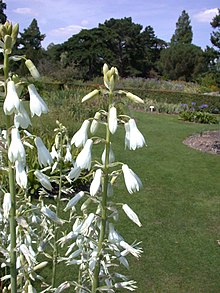
Scilla is a genus of about 30 to 80 species of bulb-forming perennial herbaceous plants in the family Asparagaceae, subfamily Scilloideae. Sometimes called the squills in English, they are native to woodlands, subalpine meadows, and seashores throughout Europe, Africa and the Middle East. A few species are also naturalized in Australasia and North America. Their flowers are usually blue, but white, pink, and purple types are known; most flower in early spring, but a few are autumn-flowering. Several Scilla species are valued as ornamental garden plants.

Scilloideae is a subfamily of bulbous plants within the family Asparagaceae. Scilloideae is sometimes treated as a separate family Hyacinthaceae, named after the genus Hyacinthus. Scilloideae or Hyacinthaceae include many familiar garden plants such as Hyacinthus (hyacinths), Hyacinthoides (bluebells), Muscari and Scilla and Puschkinia. Some are important as cut flowers.

Ornithogalum is a genus of perennial plants mostly native to southern Europe and southern Africa belonging to the family Asparagaceae. Some species are native to other areas such as the Caucasus. Some species are classified as noxious invasive weeds in some portions of North America. Growing from a bulb, species have linear basal leaves and a slender stalk, up to 30 cm tall, bearing clusters of typically white star-shaped flowers, often striped with green. The common name of the genus, star-of-Bethlehem, is based on its star-shaped flowers, after the Star of Bethlehem that appears in the biblical account of the birth of Jesus. The number of species has varied considerably, depending on authority, from 50 to 300.

Ledebouria is a genus of African bulbous perennial herbs in the Asparagus family, Asparagaceae, subfamily Scilloideae. Most members were previously part of the genus Scilla. A number of species are grown by cacti and succulent enthusiasts for their patterned leaves.

Massonia is a genus of bulbous perennial flowering plants in the family Asparagaceae, subfamily Scilloideae. It is native to southern Africa, and is found in localities such as Namaqualand with hot and dry summers, being dormant in summer and growing during winter. The genus Whiteheadia has been merged into Massonia. It is classed as a cryptophyte.

Albuca is a genus of flowering plants in the family Asparagaceae, subfamily Scilloideae. The genus is distributed mainly in southern and eastern Africa, with some species occurring in northern Africa and the Arabian Peninsula. Plants of the genus are known commonly as slime lilies.

Drimia is a genus of African, south European and south Asian flowering plants. In the APG IV classification system, it is placed in the family Asparagaceae, subfamily Scilloideae. When broadly circumscribed, the genus includes a number of other genera previously treated separately, including Litanthus, Rhodocodon, Schizobasis and Urginea.
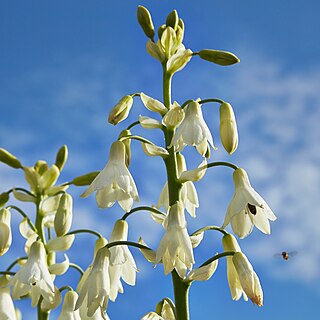
Ornithogalum candicans, known as the summer hyacinth, is a species of flowering plant in the family Asparagaceae, native to moist grassland in South Africa. It is a bulbous perennial growing to 100–120 cm (39–47 in), with strap-shaped leaves and white snowdrop-like flowers in late summer. It is still widely referenced under its synonym Galtonia candicans. Originally it had been designated as Hyacinthus candicans, by Baker in 1870.
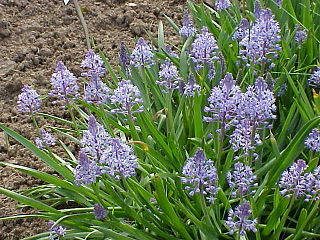
Scilla litardierei, the amethyst meadow squill or Dalmatian scilla, is a species of flowering plant in the family Asparagaceae. A bulbous perennial, with blue grape-hyacinth like flowers, blooming in late spring, much later than the more popular Siberian squill and later than Muscari which it resembles.

Barnardia is a small genus of bulbous flowering plants in the family Asparagaceae, subfamily Scilloideae. The genus has two species, one found in the Balearic Islands and north-west Africa, the other in east China, Korea, Japan and adjacent localities. It was suggested in 2012 that the two species were not closely related.

Dipcadi is a genus of bulbous flowering plants in the family Asparagaceae, subfamily Scilloideae. It is widely distributed, occurring in southern Europe, most of Africa and the Middle East through to the Indian subcontinent.

Fusifilum is a genus of bulbous flowering plants in the family Asparagaceae, subfamily Scilloideae. It is distributed in southern Africa. Some sources consider that all the species should be placed in the genus Drimia.

Merwilla is a genus of bulbous flowering plants in the family Asparagaceae, subfamily Scilloideae. It is distributed in southern Africa, from Zimbabwe to South Africa. This genus is named after the botanist Frederick Ziervogel Van der Merwe (1894–1968), who worked on this group.
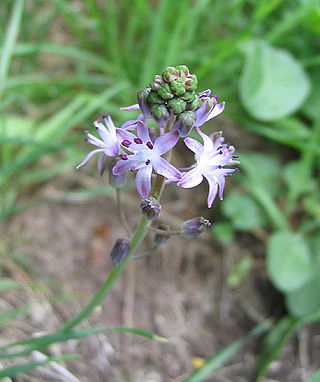
Prospero is a genus of bulbous flowering plants in the family Asparagaceae, subfamily Scilloideae. It is distributed in Europe, around the Mediterranean, and through the Middle East to the Caucasus.
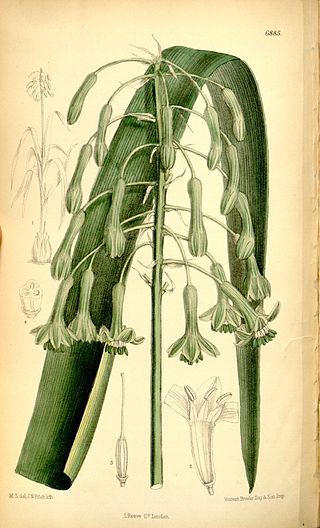
Pseudogaltonia is a genus of bulbous flowering plants in the family Asparagaceae, subfamily Scilloideae. It is distributed in southern Africa.

Pseudoprospero is a genus of bulbous flowering plants in the family Asparagaceae, subfamily Scilloideae. The genus has a single species Pseudoprospero firmifolium, which is endemic to South Africa.

Albuca shawii is a species of bulbous plant from southern Africa. It flowers in the summer and has yellow flowers on stems to about 30 cm high.

Ornithogalum broteroi, a species of the genus Ornithogalum, is a perennial bulbous flowering plant in the asparagus family (Asparagaceae). It is classed in the Cathissa group of the genus. It bears white flowers and usually a single leaf. It is found in open woods and pastures in the western part of the Iberian Peninsula and also Morocco.
